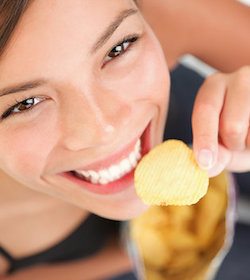Snacking in between meals has been touted over the years as an efficient dietary method to fight hunger. Unfortunately, snacking in between meals can cause unforeseen oral health problems in the form of tooth decay and sensitivity. Learn about the best and worst snacks for your teeth, and how to fight tooth decay.

How Could Snacking Ruin Teeth
Snacking itself isn’t necessarily the issue; it is what you snack on that can make the difference. Acidity of a food is a major contributor of cavity formation. Acidity is also corrosive to tooth enamel, and over time prolonged consumption of highly acidic foods and drinks can cause erosion to the point of decay or increased sensitivity.
Sugary or starchy snacks are also contributors to tooth decay. Cavity-causing bacteria feed on the sugars that are released from the foods that you consume. While bacteria themselves don’t cause cavities, it is the acid that is released as a byproduct from the bacteria that erodes tooth enamel. Favorable conditions in the mouth make it ideal for the bacteria to thrive and reproduce, putting you at higher risk for developing tooth decay. The longer that sugars and food particles sit atop the surfaces of the teeth, the more at risk you become for tooth decay.
What You Snack on Matters
Some snacks are better than others for your teeth and your body. Certain foods can rebalance the pH of the mouth, and others can disrupt the pH. Keep in mind that balance is important for a healthy mouth. Heavily acidic foods and beverages tend to drop the pH of the mouth. Among those foods are sodas, coffee, citrus fruits, breads, processed meats, sugars and artificial sugar substitutes, pasta and alcohol. While these foods aren’t bad to indulge in every once in a while, frequent consumption could put your mouth at a higher risk of tooth decay.
On the higher end of the pH scale, also known as alkaline, are most fresh fruits and vegetables. Among the foods that are on the alkaline end of the pH spectrum are sweet potatoes, grapes, kiwis, beans, cucumbers, asparagus, cauliflower, tangerines, papayas, onions and broccoli. Crunchy snacks like apples, carrots and celery have been recognized as good for teeth because they have a natural scrubbing effect on the teeth and disrupt plaque. Moreover, foods like cheese, mushrooms and green tea all contain properties that can fight tooth decay.
Flat water is a neutral pH. Water is the healthiest beverage for your teeth. Many patients have questions about the health of sparkling water, since it contains no additives but does contain carbonation. Sparkling water is actually acidic, as the carbonation is incited by carbon dioxide. A chemical reaction occurs in your mouth that converts the carbon dioxide into carbonic acid, which can wear at tooth enamel.
Prevent Cavities
Try not to brush immediately after you eat a snack, in particular after eating an acidic snack, because you risk causing erosion to the tooth enamel since it is in a compromised state. Try to eat or drink your snack in one sitting, and limit acidic beverages to be consumed during a meal when saliva flow is at its peak.
When you do brush, select a toothpaste that has cavity-protection. Flossing is also extremely important for cleaning surfaces of the teeth that brushing alone does not reach. Lastly, visit the dentist for twice-annual dental appointments for a professional exam and cleaning.
Overall, snacking can be fine for you if you take steps to protect your oral health. Keep in mind which snacks can help promote better oral health, and which snacks can impact your oral health negatively. Moreover, opt for balance- sugary or salty snacks are fine in moderation, so long as you keep up with your dental care.



